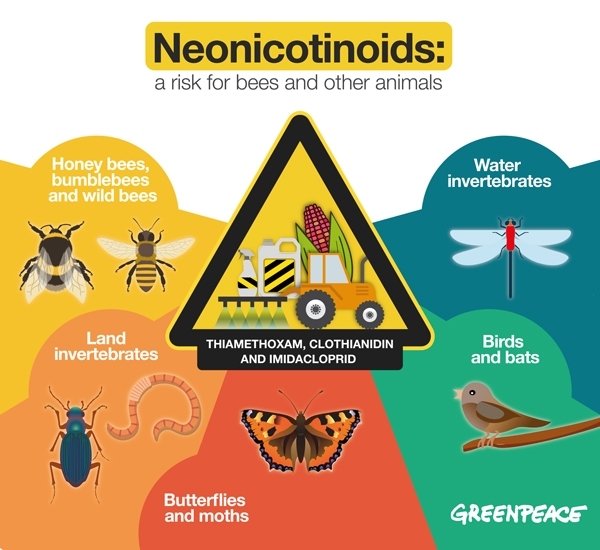Back to November 2017 Newsletter
An Update on Neonics

Kim Fellows
First introduced in the 1990s, neonics are now the most popular insecticides used globally. What sets neonics apart from older pesticides is that they are “systemic”, which means that the toxin grows into all the plant’s tissues, including the leaves, stems, pollen and nectar.
(You can refresh your memory with an intro on the issue from our August 2014 e-bulletin, where we outline the impacts on honey bees, and a more recent summary in our June 2017 e-bulletin of a study that examined the effects of neonics on bumble bee colonies.)
Alarmed by rapid declines in insect populations, an independent group of 30 scientists from all over the world came together to form a Task Force on Systemic Pesticides (TFSP), under the International Union for Conservation of Nature (IUCN).
The Task Force has adopted a science-based approach and aims to promote better informed and evidence-based decision-making. The TFSP has produced a Worldwide Integrated Assessment of the Effects of Systemic Pesticides on Biodiversity and Ecosystems (WIA). The first WIA included a meta-analysis of 1121 studies from 2009-2014, and a more recent update reviews over 500 new, peer-reviewed studies published since 2014 (WIA2). All publications of the TFSP (WIA and WIA2) have been subject to standard scientific peer-review procedures of the journal Environmental Science and Pollution Research, in which the results were published.
In September 2017, York University hosted a symposium organized by the David Suzuki Foundation, featuring the TFSP. Panel members presented their findings, which confirm that neonics are a major worldwide threat to biodiversity, ecosystems, and ecosystem services. One of the studies, for instance, examined the effect of neonics on amphibians and found that at certain concentrations, neonics compromised juvenile frog’s response behaviour to predation, making them more vulnerable to attacks. The presentations also included a study that hints that some neonics may affect the developing nervous system in human fetuses, although more research is needed on this topic.
In North America, no neonic bans have been introduced as yet, although Ontario has an action plan to reduce the number of acres planted with neonic-treated soybean and corn seed by 80 percent. You can read more about the Ontario Pollinator Health Plan in our January 2017 e-bulletin.
Jean-Marc Bonmatin, the Deputy Chairman of the TFSP, was quoted in The Globe and Mail as saying: “Overall, the global experiment with neonics is emerging a clear example of pest-control failure. Governments around the world – including Canada – must follow the lead of countries such as France to ban neonics and move toward sustainable, integrated pest-management models, without delay. The health of our ecosystems and food sources depends on it.”
**
Kim Fellows is the Outreach Coordinator of Pollination Canada.
Photo: Greenpeace International
Not yet a member?
An annual membership to Seeds of Diversity gives you access to our seed exchange, seed grow-out programs, and our online news.

We depend on donations to do our work.

Thank you for your support!
